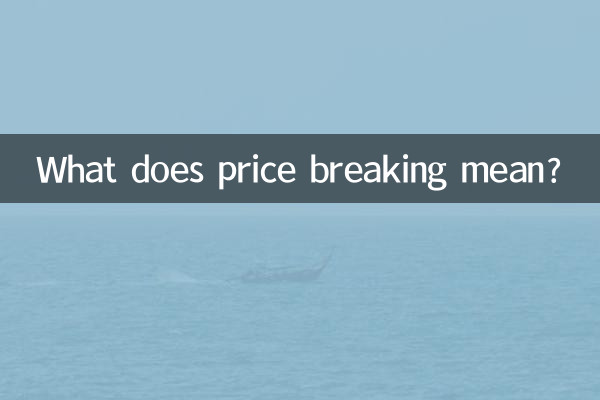What does price breaking mean?
In the world of business and marketing, “breaking the price” is a common term, but many people don’t fully understand its meaning and the logic behind it. This article will combine the hot topics and hot content on the Internet in the past 10 days, deeply analyze the concept, application scenarios and impact of "breaking prices", and display relevant cases through structured data.
1. What is a broken price?

Price breaking, as the name suggests, means that the price of goods or services is lower than the normal market level, or even lower than the cost price. This strategy is often used to attract consumers, clear inventory quickly, or capture market share. Price-breaking behavior may be a short-term promotional tool or a long-term competitive strategy.
2. Common scenarios of broken prices
1.E-commerce promotion: For example, during shopping festivals such as "Double 11" and "618", merchants attract consumers to place orders by lowering prices.
2.New product promotion: In order to quickly open up the market, new products may be sold at reduced prices.
3.Inventory clearing: Backlogged goods can quickly withdraw funds through price reduction.
4.Suppression of competition: Some companies compete for market share by lowering prices to suppress competitors.
3. Popular price-breaking cases across the Internet in the past 10 days
| Brand/Platform | Price-breaking products | original price | price after price break | Discount range |
|---|---|---|---|---|
| A domestic mobile phone brand | flagship model | 3999 yuan | 2999 yuan | 25% |
| An e-commerce platform | Smart home appliances | 1299 yuan | 899 yuan | 30.8% |
| A fast moving consumer brand | New drinks | 5 yuan/bottle | 3 yuan/bottle | 40% |
4. Advantages and Disadvantages of Price Breaking
advantage:
1. Rapidly increase sales and increase market share in the short term.
2. Attract new customers and increase brand exposure.
3. Clean up inventory and reduce capital occupation.
shortcoming:
1. It may trigger a price war and damage industry profits.
2. Long-term price drops will lead to a decline in brand value.
3. Consumers may be price sensitive and reduce brand loyalty.
5. How to reasonably use the price-breaking strategy?
1.Clear goals: Is the price reduction to clear inventory, attract new products, or to suppress competing products? The goals are different and the strategies are also different.
2.Control duration: Short-term price cuts can avoid long-term damage to the brand.
3.combined with marketing: Amplify the price-breaking effect through advertising, social media, etc.
4.Monitoring effect: Track sales, profits and other data in real time and adjust strategies in a timely manner.
6. How do consumers view broken prices?
According to the analysis of social media data in the past 10 days, consumers’ reactions to the price break are polarized:
| opinion classification | Proportion | representative comments |
|---|---|---|
| supporter | 65% | “Finally, when the price dropped, I decided to place an order!” |
| Skeptics | 25% | "It's cheap but not good. It may be a defective product that was cleared out of stock." |
| wait-and-see | 10% | “Look at the quality first and then decide.” |
7. Summary
Price breaking is a double-edged sword. If used well, it can quickly open up the market; if used improperly, it may damage the foundation of the brand. Enterprises and consumers should view the phenomenon of broken prices rationally and avoid falling into the quagmire of blind price wars. For merchants, breaking prices is just one of the marketing tools, and they must ultimately return to the products and services themselves; for consumers, breaking prices is a good opportunity to make money, but they must also be wary of the low-price trap.
In the future, as market competition intensifies, price breaking may become more common. How to find a balance between price-breaking and brand value will be a question that companies and marketers need to continue to think about.

check the details

check the details